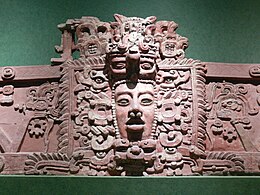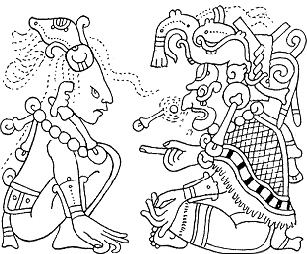
Maya or Mayan mythology is part of Mesoamerican mythology and comprises all of the Maya tales in which personified forces of nature, deities, and the heroes interacting with these play the main roles. The myths of the Pre-Hispanic era have to be reconstructed from iconography. Other parts of Mayan oral tradition are not considered here.
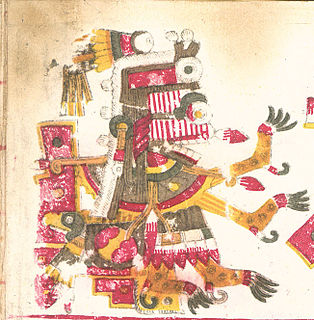
In Aztec religion, Ītzpāpālōtl[iːt͡spaːˈpaːlot͡ɬ] was a striking skeletal warrior goddess who ruled over the paradise world of Tamoanchan, the paradise of victims of infant mortality and the place identified as where humans were created. She is the mother of Mixcoatl and is particularly associated with the moth Rothschildia orizaba from the family Saturniidae. Some of her associations are birds and fire. However, she primarily appears in the form of the Obsidian Butterfly.

Mayapan is a Pre-Columbian Maya site a couple of kilometers south of the town of Telchaquillo in Municipality of Tecoh, approximately 40 km south-east of Mérida and 100 km west of Chichen Itza; in the state of Yucatán, Mexico. Mayapan was the political and cultural capital of the Maya in the Yucatán Peninsula during the Late Post-Classic period from the 1220s until the 1440s. Estimates of the total city population are 15,000–17,000 people, and the site has more than 4,000 structures within the city walls, and additional dwellings outside.

The Mesoamerican ballgame was a sport with ritual associations played since at least 1650 BC by the pre-Columbian people of Ancient Mesoamerica. The sport had different versions in different places during the millennia, and a newer, more modern version of the game, ulama, is still played by the indigenous populations in some places.
Tzolkʼin is the name bestowed by Mayanists on the 260-day Mesoamerican calendar originated by the Maya civilization of pre-Columbian Mesoamerica.

La Pirámide, known as the Temple of Kukulcán, is a Mesoamerican step-pyramid that dominates the center of the Chichen Itza archaeological site in the Mexican state of Yucatán. The pyramid building is more formally designated by archaeologists as Chichen Itza Structure 5B18.
Ndaxagua, locally known in Spanish as El Puente Colosal is a natural cave with double entrance and archaeological site, located in the extreme northern end of the Coixtlahuaca Basin, central-southern Mexico. The cave was most likely used by Mesoamerican cultures such as the Zapotec and Mixtec as well.

The use of jade in Mesoamerica for symbolic and ideological ritual was highly influenced by its rarity and value among pre-Columbian Mesoamerican cultures, such as the Olmec, the Maya, and the various groups in the Valley of Mexico. Although jade artifacts have been created and prized by many Mesoamerican peoples, the Motagua River valley in Guatemala was previously thought to be the sole source of jadeite in the region.

The Aztec religion originated from the indigenous Aztecs of central Mexico. Like other Mesoamerican religions, it also has practices such as human sacrifice in connection with many religious festivals which are in the Aztec calendar. This polytheistic religion has many gods and goddesses; the Aztecs would often incorporate deities that were borrowed from other geographic regions and peoples into their own religious practices.

Maya architecture spans several thousands of years, several eras of political change, and architectural innovation before the Spanish colonization of the Americas. Often, the buildings most dramatic and easily recognizable as creations of the Maya peoples are the step pyramids of the Terminal Preclassic Maya period and beyond. Based in general Mesoamerican architectural traditions, the Maya utilized geometric proportions and intricate carving to build everything from simple houses to ornate temples. This article focuses on the more well-known pre-classic and classic examples of Maya architecture. The temples like the ones at Palenque, Tikal, and Uxmal represent a zenith of Maya art and architecture. Through the observation of numerous elements and stylistic distinctions, remnants of Maya architecture have become an important key to understanding their religious beliefs and culture as a whole.

The traditional Maya religion of the extant Maya peoples of Guatemala, Belize, western Honduras, and the Tabasco, Chiapas, Quintana Roo, Campeche and Yucatán states of Mexico is part of the wider frame of Mesoamerican religion. As is the case with many other contemporary Mesoamerican religions, it results from centuries of symbiosis with Roman Catholicism. When its pre-Hispanic antecedents are taken into account, however, traditional Maya religion has already existed for more than two and a half millennia as a recognizably distinct phenomenon. Before the advent of Christianity, it was spread over many indigenous kingdoms, all with their own local traditions. Today, it coexists and interacts with pan-Mayan syncretism, the 're-invention of tradition' by the Pan-Maya movement, and Christianity in its various denominations.

Chicomoztoc is the name for the mythical origin place of the Aztec Mexicas, Tepanecs, Acolhuas, and other Nahuatl-speaking peoples of the central Mexico region of Mesoamerica, in the Postclassic period.

Mesoamerican architecture is the set of architectural traditions produced by pre-Columbian cultures and civilizations of Mesoamerica, traditions which are best known in the form of public, ceremonial and urban monumental buildings and structures. The distinctive features of Mesoamerican architecture encompass a number of different regional and historical styles, which however are significantly interrelated. These styles developed throughout the different phases of Mesoamerican history as a result of the intensive cultural exchange between the different cultures of the Mesoamerican culture area through thousands of years. Mesoamerican architecture is mostly noted for its pyramids, which are the largest such structures outside of Ancient Egypt.

Death rituals were an important part of Maya religion. The Maya greatly respected death; they were taught to fear it and grieved deeply for the dead. They also believed that certain deaths were more noble than others.
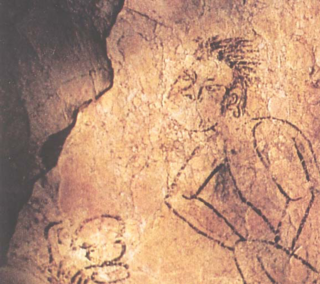
Naj Tunich is a series of pre-Columbian era natural caves outside the village of La Compuerta, roughly 35 km east of Poptún in Guatemala. The site was a Maya ritual pilgrimage site during the Classic period. Artifacts show that the cave was accessed primarily during the Early Classic period. Deposits become rarer during the Late Classic period. The fame of the cave, however, rests on its long Late Classic hieroglyphic texts as well as on a considerable number painted scenes and figures.

The Feathered Serpent was a prominent supernatural entity or deity, found in many Mesoamerican religions. It is still called Quetzalcoatl among the Aztecs, Kukulkan among the Yucatec Maya, and Q'uq'umatz and Tohil among the K'iche' Maya.

Chichen Itza was a large pre-Columbian city built by the Maya people of the Terminal Classic period. The archeological site is located in Tinúm Municipality, Yucatán State, Mexico.
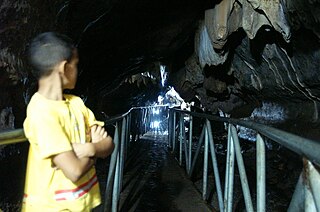
Talgua Cave,, is a cave located in the Olancho Valley in the municipality of Catacamas in northeastern Honduras. The misnomer “The Cave of the Glowing Skulls” was given to the cave because of the way that light reflects off of the calcite deposits found on the skeletal remains found there. The site has gained the interest of archaeologists studying cave burials of Central America and of Mesoamerica as one of the most extensive Early to Middle Pre-Classic ossuary cave sites currently known to have been in contact with the Maya societies of nearby Mesoamerica. It provides many valuable clues to how the inhabitants of the Talgua Cave may have been an important link between Pre-Columbian Mesoamerica and parts further south and east in Central America and extending into those societies in northern South America, a region known as the Isthmo-Colombian Area.

The Maya death gods, known by a variety of names, are two basic types of death gods who are respectively represented by the 16th-century Yucatec deities Hunhau and Uacmitun Ahau mentioned by Spanish Bishop Landa. Hunhau is the lord of the Underworld. Iconographically, Hunhau and Uacmitun Ahau correspond to the Gods A and A' . In recent narratives, particularly in the oral tradition of the Lacandon people, there is only one death god, who acts as the antipode of the Upper God in the creation of the world and of the human body and soul. This death god inhabits an Underworld that is also the world of the dead. As a ruler over the world of the dead, the principal death god corresponds to the Aztec deity Mictlantecuhtli. The Popol Vuh has two leading death gods, but these two are really one: Both are called "Death," but while one is known as "One Death," the other is called "Seven Death." They were vanquished by the Hero Twins.

Xibun is an alternate Mayan spelling of Sibun that appears on some Spanish colonial-period maps of the region, and is sometimes used to refer to:
